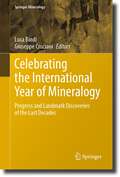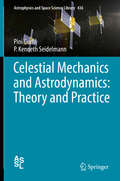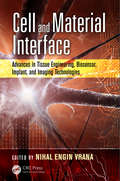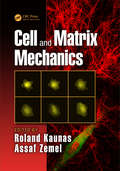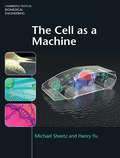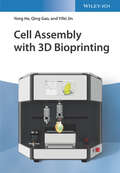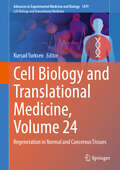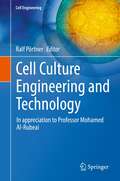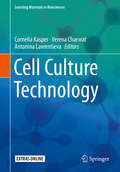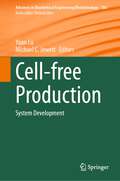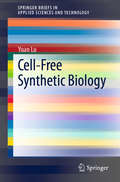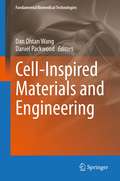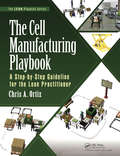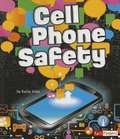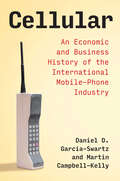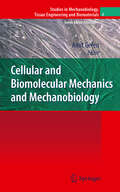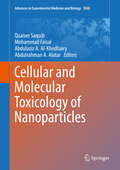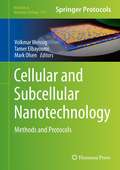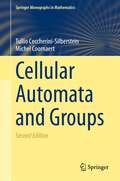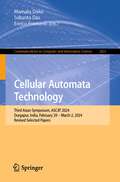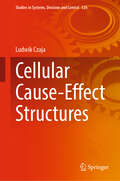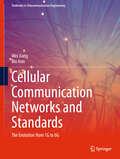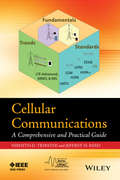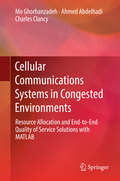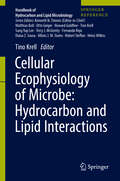- Table View
- List View
Celebrating the International Year of Mineralogy: Progress and Landmark Discoveries of the Last Decades (Springer Mineralogy)
by Luca Bindi Giuseppe CrucianiThis volume celebrates mineral sciences and what are considered the most important progresses and breakthroughs in this discipline. Authoritative authors, who, in most cases, are the direct discoverers recount the steps of their research, which represent landmark developments of mineralogy and mineralogical crystallography.
Celestial Mechanics and Astrodynamics: Theory and Practice (Astrophysics and Space Science Library #436)
by Pini Gurfil P. Kenneth SeidelmannThis volume is designed as an introductory text and reference book for graduate students, researchers and practitioners in the fields of astronomy, astrodynamics, satellite systems, space sciences and astrophysics. The purpose of the book is to emphasize the similarities between celestial mechanics and astrodynamics, and to present recent advances in these two fields so that the reader can understand the inter-relations and mutual influences. The juxtaposition of celestial mechanics and astrodynamics is a unique approach that is expected to be a refreshing attempt to discuss both the mechanics of space flight and the dynamics of celestial objects. "Celestial Mechanics and Astrodynamics: Theory and Practice" also presents the main challenges and future prospects for the two fields in an elaborate, comprehensive and rigorous manner. The book presents homogenous and fluent discussions of the key problems, rendering a portrayal of recent advances in the field together with some basic concepts and essential infrastructure in orbital mechanics. The text contains introductory material followed by a gradual development of ideas interweaved to yield a coherent presentation of advanced topics.
Cell and Material Interface: Advances in Tissue Engineering, Biosensor, Implant, and Imaging Technologies (Devices, Circuits, and Systems)
by Nihal Engin VranaA significant portion of biomedical applications necessitates the establishment of an interface between the cells of the patient and the components of the device. In many cases, such as in implants and engineered tissues, the interaction of the cells with the biomaterial is one of the main determinants of the success of the system. Cell and Material Interface: Advances in Tissue Engineering, Biosensor, Implant, and Imaging Technologies explores this interaction and its control at length scales ranging from the nano to the macro.Featuring contributions from leading molecular biologists, chemists, and material scientists, this authoritative reference: Presents practical examples of cell and material interface-based applications Reflects the interdisciplinary nature of bioengineering, covering topics such as biosensing, immunology, and controlled delivery Explains the role of the cell and material interface in the context of cardiac and skin tissue engineering, nanoparticles, natural polymers, and more Cell and Material Interface: Advances in Tissue Engineering, Biosensor, Implant, and Imaging Technologies addresses concepts essential to biomaterial production methods and cell and material interactions. The book provides a solid starting point for elucidating and exploiting the different aspects of cellular interactions with materials for biomedical engineering.
Cell and Matrix Mechanics
by Roland Kaunas Assaf ZemelExplores a Range of Multiscale Biomechanics/Mechanobiology ConceptsCell and Matrix Mechanics presents cutting-edge research at the molecular, cellular, and tissue levels in the field of cell mechanics. This book involves key experts in the field, and covers crucial areas of cell and tissue mechanics, with an emphasis on the roles of mechanical forc
The Cell as a Machine (Cambridge Texts in Biomedical Engineering)
by Michael Sheetz Hanry YuThis unique introductory text explains cell functions using the engineering principles of robust devices. Adopting a process-based approach to understanding cell and tissue biology, it describes the molecular and mechanical features that enable the cell to be robust in operating its various components, and explores the ways in which molecular modules respond to environmental signals to execute complex functions. The design and operation of a variety of complex functions are covered, including engineering lipid bilayers to provide fluid boundaries and mechanical controls, adjusting cell shape and forces with dynamic filament networks, and DNA packaging for information retrieval and propagation. Numerous problems, case studies and application examples help readers connect theory with practice, and solutions for instructors and videos of lectures accompany the book online. Assuming only basic mathematical knowledge, this is an invaluable resource for graduate and senior undergraduate students taking single-semester courses in cell mechanics, biophysics and cell biology.
Cell Assembly with 3D Bioprinting
by Yong He Qing Gao Yifei JinProvides an up-to-date outline of cell assembly methods and applications of 3D bioprinting Cell Assembly with 3D Bioprinting provides an accesible overview of the layer-by-layer manufacturing of living structures using biomaterials. Focusing on technical implemention in medical and bioengineering applications, this practical guide summarize each key aspect of the 3D bioprinting process. Contributions from a team of leading researchers describe bioink preparation, printing method selection, experimental protocols, integration with specific applications, and more. Detailed, highly illustrated chapters cover different bioprinting approaches and their applications, including coaxial bioprinting, digital light projection, direct ink writing, liquid support bath-assisted 3D printing, and microgel-, microfiber-, and microfluidics-based biofabrication. The book includes practical examples of 3D bioprinting, a protocol for typical 3D bioprinting, and relevant experimental data drawn from recent research.* Highlights the interdisciplinary nature of 3D bioprinting and its applications in biology, medicine, and pharmaceutical science * Summarizes a variety of commonly used 3D bioprinting methods * Describes the design and preparation of various types of bioinks * Discusses applications of 3D bioprinting such as organ development, toxicological research, clinical transplantation, and tissue repair Covering a wide range of topics, Cell Assembly with 3D Bioprinting is essential reading for advanced students, academic researchers, and industry professionals in fields including biomedicine, tissue engineering, bioengineering, drug development, pharmacology, bioglogical screening, and mechanical engineering.
Cell Biology and Translational Medicine, Volume 24: Regeneration in Normal and Cancerous Tissues (Advances in Experimental Medicine and Biology #1479)
by Kursad TurksenThis volume in the Cell Biology and Translational Medicine series continues to explore the potential utility of stem cells in regenerative medicine. Topics covered include various aspects of stem cells in regeneration, both in health and cancer. These include research into microenvironments, signals, exosomes, biomaterials and their role in regeneration in general and in various types of cancer. A goal of the series continues to be to highlight timely, often emerging topics and novel approaches that can accelerate the utility of stem cells in regenerative medicine.
Cell Culture Engineering and Technology: In appreciation to Professor Mohamed Al-Rubeai (Cell Engineering #10)
by Ralf PörtnerThis contributed volume is dedicated towards the progress achieved within the last years in all areas of Cell Culture Engineering and Technology. It comprises contributions of active researchers in the field of cell culture development for the production of recombinant proteins, cell line development, cell therapy and gene therapy, with consideration of media development, process scale-up, reactor design, monitoring and control and model-assisted strategies for process design. The knowledge and expertise of the authors cover disciplines like cell biology, engineering, biotechnology and biomedical sciences. This book is conceived for graduate students, postdoctoral fellows and researchers interested in the latest developments in Cell Engineering.
Cell Culture Technology (Learning Materials in Biosciences #4)
by Cornelia Kasper Verena Charwat Antonina LavrentievaThis textbook provides an overview on current cell culture techniques, conditions, and applications specifically focusing on human cell culture. This book is based on lectures, seminars and practical courses in stem cells, tissue engineering, regenerative medicine and 3D cell culture held at the University of Natural Resources and Life Sciences Vienna BOKU and the Gottfried Wilhelm Leibniz University Hannover, complemented by contributions from international experts, and therefore delivers in a compact and clear way important theoretical, as well as practical knowledge to advanced graduate students on cell culture techniques and the current status of research. The book is written for Master students and PhD candidates in biotechnology, tissue engineering and biomedicine working with mammalian, and specifically human cells. It will be of interest to doctoral colleges, Master- and PhD programs teaching courses in this area of research.
Cell-free Production: System Development (Advances in Biochemical Engineering/Biotechnology #186)
by Yuan Lu Michael C. JewettThis book reviews the development of cell-free production platforms and offers an authoritative perspective of the latest advances and methodologies in cell-free production systems. Readers will discover the biomanufacturing potential of in vitro biotransformation (ivBT) employing purified cascade multi-enzymes, the development of hydrogel-based multi-enzymatic systems for biosynthesis, and novel insights into the optimization of biocatalytic processes. Additionally, the book explores the cell-free production and regeneration of cofactors, shedding light on strategies to enhance the efficiency and sustainability of cellular processes. In this book, particular attention is given to the progress of cell-free in vitro evolution techniques for optimizing enzyme performance, and the book also presents the integration of rapid and finely-tuned expression systems for deployable sensing applications, revolutionizing the field of biosensing. The synthesis and electrophysiological analysis of multipass voltage-gated ion channels tethered in microsomal membranes are explored, providing a deep understanding of cellular function at the molecular level. Lastly, the book covers compartmentalized cell-free expression systems for building synthetic cells, showcasing the potential for constructing artificial cellular systems with unique functionalities. Given its breadth, this book appeals to academics, researchers, and professionals interested in the forefront of biotechnology, and together with the companion volume “Cell-free Macromolecular Synthesis”, both books highlight the research progresses on the basic and applied research of cell-free production systems in the last few years, being invaluable resources in the field.Chapter “Cell-free synthesis and electrophysiological analysis of multipass voltage-gated ion channels tethered in microsomal membranes” is available open access under a Creative Commons Attribution 4.0 International License via link.springer.com.
Cell-Free Synthetic Biology (SpringerBriefs in Applied Sciences and Technology)
by Yuan LuThis book describes advanced studies in cell-free synthetic biology, an emerging biotechnology that focuses on cell-free protein synthesis and cell-free systems for fundamental and industrial research in areas such as genetic circuit design, small-molecule synthesis, complicated-macromolecule synthesis, unnatural-macromolecule synthesis, high-throughput screening, artificial cells, and biomaterials. Cell-free synthetic biology is now an integral part of developing fields like nanotechnology, materials science, and personalized medicine. The book discusses the main research directions in the development of cell-free systems, as well as a number of applications of cell-free synthetic biology, ranging from structural biology to the human health industry. It is intended for students and researchers in life sciences, synthetic biology, bioengineering, and chemical engineering.
Cell-Inspired Materials and Engineering (Fundamental Biomedical Technologies)
by Daniel Packwood Dan Ohtan WangThis book highlights cutting-edge studies in the development of cell-inspired biomaterials and synthetic materials that manipulate cell functions and provide the next generation with contemporary tools for treating complex human diseases. It explores the convergence of synthetic materials with cell and molecular biology and surveys how functional materials, when patterned with spatial and temporal precision, can be used effectively to maintain cell proliferation and phenotype in vitro, to trigger specific cell functions, and to redirect cell-fate decisions. Human stem cells are a frequently discussed subject in this book. This is an ideal book for students, cell biologists, researchers interested in interdisciplinary research, and biomedical engineers. This book also: Highlights successfully developed technologies in cell engineering that make possible new therapeutic development for previously untreatable conditions Covers topics including bio-inspired micro patterning, DNA origami technology, synthetic NOS inspired by compartmentalized signaling in cells, and light-induced depolarization of the cell membrane Illustrates in detail the use of stem cells and synthetic scaffolds to model ethically sensitive embryonic tissues and organs
The Cell Manufacturing Playbook: A Step-by-Step Guideline for the Lean Practitioner (The\lean Playbook Ser.)
by Chris A. OrtizThis book describes how to effectively implement cell manufacturing. It covers the eight Wastes of Lean and the six Lean metrics that are recommended in each implementation and a description of what cell manufacturing is and its application to improving operational processes.
Cell Phone Safety
by Kathy Allen Frank W. BakerIf you get a text from a stranger, do you know what to do? Don't worry if you don't. This book is here to help! Learn tech-savvy ways to keep your cell phone a safe zone without taking away all the fun!
Cellular: An Economic and Business History of the International Mobile-Phone Industry (History of Computing)
by Daniel D. Garcia-Swartz Martin Campbell-KellyTracks the evolution of the international cellular industry from the late 1970s to the present.The development of the mobile-phone industry into what we know today required remarkable cooperation between companies, governments, and industrial sectors. Companies developing cellular infrastructure, cellular devices, cellular network services, and eventually software and mobile semiconductors had to cooperate, not simply compete, with each other. In this global history of the mobile-phone industry, Daniel D. Garcia-Swartz and Martin Campbell-Kelly examine its development in the United States, Europe, Japan, and several emerging economies, including China and India. They present the evolution of mobile phones from the perspective of vendors of telephone equipment and network operators, users whose lives have been transformed by mobile phones, and governments that have fostered specific mobile-phone standards. Cellular covers the technical aspects of the cellphone, as well as its social and political impact. Beginning with the 1980s, the authors trace the development of closed (proprietary) and open (available to all) cellular standards, the impact of network effects as cellular adoption increased, major technological changes affecting mobile phone hardware, and the role of national governments in shaping the industry. The authors also consider the changing roles that cellular phones have played in the everyday lives of people around the world and the implications 5G technology may have for the future. Finally, they offer statistics on how quickly the cellular industry grew in different regions of the world and how firms competed in those various markets. Cellular is published in the History of Computing Series. This distinguished series has played a major role in defining scholarship in the history of computing. Hallmarks of the series are its technical detail and interpretation of primary source materials.
Cellular and Biomolecular Mechanics and Mechanobiology (Studies in Mechanobiology, Tissue Engineering and Biomaterials #4)
by Amit GefenThis book describes these exciting new developments, and presents experimental and computational findings that altogether describe the frontier of knowledge in cellular and biomolecular mechanics, and the biological implications, in health and disease. The book is written for bioengineers with interest in cellular mechanics, for biophysicists, biochemists, medical researchers and all other professionals with interest in how cells produce and respond to mechanical loads.
Cellular and Molecular Toxicology of Nanoparticles
by Quaiser Saquib Mohammad Faisal Abdulaziz A. Al-Khedhairy Abdulrahman A. AlatarThis edited book is a compilation of findings on the molecular and cellular toxicity of nanoparticles (NPs) in animal cell, human cells, invertebrates. The varied selection of test models will provide better understanding about the horizon of NPs toxicity. Interaction of NPs with cells and its organelles can induce toxicological consequences, including transcriptional and translational alterations, DNA damage, cytotoxicity, oxidative stress, mitochondrial dysfunction and cell death. NPs can get internalized in cells through phagocytosis, macropinocytosis, receptor-mediated endocytosis and passive penetration, which can affect varied cell types. Readers will be benefited with the compilations on basic and molecular facet of NPs toxicity. The chapters will provide a comprehensive information on the state-of-the-art methodologies. The application of toxicogenomic approaches, which is already established in nanotoxicology, has been given special consideration to unravel the toxicodynamics of nanomaterials. Among these approaches, the high-throughput RNA sequencing (RNA-Seq), which is able to build a complete map of transcriptome across different cell types and perturbations upon NPs exposure has been included. The readers are also introduced to the less studied topic on the adsorption of biomolecules (mainly proteins) on the NPs surface, constituting the so-called “biomolecular corona”. The book has been designed for scientists engaged in NPs toxicity research. Nonetheless, it should be of interest to a variety of scientific disciplines including marine biology, environmental pollution, genetics, pharmacology, medicine, drug and food material sciences, consumer products. Also, the compilations will be of interest to the environmental watchdogs, federal regulators, risk assessors and the policy makers.
Cellular and Subcellular Nanotechnology: Methods and Protocols (Methods in Molecular Biology #991)
by Volkmar Weissig Tamer Elbayoumi Mark OlsenIn Cellular and Subcellular Nanotechnology: Methods and Protocols expert researchers in the field detail the most recent advances which have been made in utilizing the enormous potential of nanotechnology for probing, imaging and manipulating life on a cellular and subcellular level. Written in the highly successful Methods in Molecular BiologyTM series format, chapters include introductions to their respective topics, lists of the necessary materials and reagents, step-by-step, readily reproducible laboratory protocols, and key tips on troubleshooting and avoiding known pitfalls. Authoritative and Practical, Cellular and Subcellular Nanotechnology: Methods and Protocols seeks to aid scientists in the further study of applying nanotechnology to all areas of biomedical sciences.
Cellular Automata and Groups (Springer Monographs in Mathematics)
by Tullio Ceccherini-Silberstein Michel CoornaertThis unique book provides a self-contained exposition of the theory of cellular automata on groups and explores its deep connections with recent developments in geometric and combinatorial group theory, amenability, symbolic dynamics, the algebraic theory of group rings, and other branches of mathematics and theoretical computer science. The topics treated include the Garden of Eden theorem for amenable groups, the Gromov–Weiss surjunctivity theorem, and the solution of the Kaplansky conjecture on the stable finiteness of group rings for sofic groups. Entirely self-contained and now in its second edition, the volume includes 10 appendices and more than 600 exercises, the solutions of which are presented in the companion book Exercises in Cellular Automata and Groups (2023) by the same authors. It will appeal to a large audience, including specialists and newcomers to the field.
Cellular Automata Technology: Third Asian Symposium, ASCAT 2024, Durgapur, India, February 29–March 2, 2024, Revised Selected Papers (Communications in Computer and Information Science #2021)
by Mamata Dalui Sukanta Das Enrico FormentiThis book constitutes the refereed conference proceedings of the Third Asian Symposium on Cellular Automata Technology, ASCAT 2024, held in Durgapur, India, during February 29 - March 2, 2024.The 15 full papers presented in this book were carefully reviewed and selected from 33 submissions. The symposium aims to explore the latest advancements, methodologies, and interdisciplinary connections that showcase the versatility and potential impact of cellular automata in contemporary research.
Cellular Cause-Effect Structures (Studies in Systems, Decision and Control #526)
by Ludwik CzajaThis book presents the adaptation of cause-effect structures to the formal description of phenomena such as the behaviour of living objects, the mutual communication of living cells, but also such as the growth of crystals and other natural processes. The system of cause-effect structures has been designed for the description and analysis of objects with dispersed components, acting concurrently and synchronizing and communicating one another. This adaptation consists in customizing generic semantics of cause-effect structures to semantics specific to the behaviour of natural objects. That is creating evolution rules for the formal models of these objects. However, the structural, algebraic properties of cause-effect structures are retained. The activity of cellular cause-effect structures is supposed to imitate the activity of cellular automata, the formal system intended for the above-mentioned aims. But operations on syntactic constructions, in particular their transformations and simplification, are the same as for the general cause-effect structures. These algebraic operations are also used to perform certain geometric/topological conversions of location bases for the cellular cause-effect structures, like flat surfaces into cylindrical or toroidal. This is depicted by numerous illustrations. An adaptation of cause-effect structures to other formal descriptions of some natural phenomena, such as reaction systems, is provided in book 331 of the “Lecture Notes in Networks and Systems” series, whereas the complete description of cause-effect structures, in book 45.
Cellular Communication Networks and Standards: The Evolution from 1G to 6G (Textbooks in Telecommunication Engineering)
by Wei Jiang Bin HanThis textbook provides a comprehensive review of the evolution of mobile communications and networking from the birth of cellular networks to the forthcoming sixth-generation mobile communications, which is envisioned to be commercially deployed first in 2030. New students who are coming to wireless communications/electrical engineering/computer networking/telecommunications and network engineering can benefit from this book by quickly grasping the whole history of cellular networks, understanding its trends. This tutorial styled textbook provides a comprehensive overview, but also provides details of the system design aspects of the various cellular generations up to 6G and how they build on each other. The book also gives the student an overview of different cellular generations’ motivations, core technologies, architecture, key performance indicators, killer applications, market drivers, and the general/main features of each. The authors capture the big picture and fundamental drivers of wireless communication technologies, and then motivate students to understand the importance of learning related subjects such as electromagnetics theory, antenna design, analog and digital circuits, signal processing, Internet protocols, artificial intelligence, etc. The book features homework questions and case studies throughout.
Cellular Communications: A Comprehensive and Practical Guide
by Jeffrey H. Reed Nishith TripathiEven as newer cellular technologies and standards emerge, many of the fundamental principles and the components of the cellular network remain the same. Presenting a simple yet comprehensive view of cellular communications technologies, Cellular Communications provides an end-to-end perspective of cellular operations, ranging from physical layer details to call set-up and from the radio network to the core network. This self-contained source forpractitioners and students represents a comprehensive survey of the fundamentals of cellular communications and the landscape of commercially deployed 2G and 3G technologies and provides a glimpse of emerging 4G technologies.
Cellular Communications Systems in Congested Environments: Resource Allocation and End-to-End Quality of Service Solutions with MATLAB
by Ahmed Abdelhadi Mo Ghorbanzadeh Charles ClancyThis book presents a mathematical treatment of the radio resource allocation of modern cellular communications systems in contested environments. It focuses on fulfilling the quality of service requirements of the living applications on the user devices, which leverage the cellular system, and with attention to elevating the users' quality of experience. The authors also address the congestion of the spectrum by allowing sharing with the band incumbents while providing with a quality-of-service-minded resource allocation in the network. The content is of particular interest to telecommunications scheduler experts in industry, communications applications academia, and graduate students whose paramount research deals with resource allocation and quality of service.
Cellular Ecophysiology of Microbe: Hydrocarbon and Lipid Interactions
by Tino KrellThis book assembles concisely written chapters by world-leaders in the field summarizing recent advances in understanding microbial responses to hydrocarbons. Subjects treated include mechanisms of sensing, hydrocarbon tolerance and degradation as well as an overview on hydrophobic modification of biomolecules. Other chapters are dedicated to issues related to the reduced bioavailability of hydrocarbons, which differentiates this class of compounds form many others, but which of central importance to understand the ecophysiological consequences. This book should be standard literature in any laboratory working in this area.
